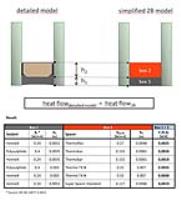 Add My Company
Add My Company
Sign In

A report has been commissioned by Thermoseal Group and produced by an independent warm edge consultant that shows a comparison of the thermal performance through the edge of insulated glass, including: Warm Edge Spacer Bar, Desiccant, PIB and Sealant. The results demonstrate an enlightening change in the order of thermal performance of Foam Spacer Systems and Spacer Tube Systems.
Surely this should be the true basis for exchangeability within BFRC Window Energy Ratings? The question of which is posed by Mark Hickox, Sales Director at Thermoseal Group Limited. Mark Continues:
As a significant distributor in the insulated glass (IG) component supply market and now as a manufacturer of our own range of warm edge spacers, we have been heavily involved in the debates relating to manufacturing standards and how IG components influence Window Energy Ratings (WERs). The main focus which has been well documented in the press is in relation to debates about the exact performance of warm edge spacers – whose is better and by what fractions.
If you look at the figures closely, although spacer bars are proven to affect WERs, it is better to look more closely at thermal transfer at the edge of the unit incorporating all of the edge components including the spacer, desiccant, PIB, and secondary sealant. This is particularly important when you look at single seal systems such as foam spacer which use a minimum sealant depth of 5mm. In this case, there is a greater influence of the sealant which shows a negative effect on the overall thermal rating at the window edge.
The report includes thermal calculations using the Two-Box-Model. As per the drawings below which have been extracted from the report, the heat flow is calculated including Box 1 (the secondary sealant) and Box 2 (the spacer, PIB and desiccant combination).
It is the column on the far right which shows the resulting figures. As you can see, Thermobar shows the lowest calculated value and hence the best thermal performance across the edge of a glazing unit. Therefore, there should be no question that Thermobar can be substituted for Foam Spacer systems in WER simulation reports without the requirement for re-calculation.
An additional point to reference when considering this report is that a sealant depth of 5mm on single seal foam spacer systems is derived more in terms of what is best in a WER calculation as opposed to what is best in terms of the performance and life of the glazing unit. This is demonstrated when it comes to the reality of meeting the requirements of EN1279 Part 3 standards with such a system. If proposed changes to documentation go ahead, then by the end of 2013 documented evidence of the performance of foam spacer systems within EN1279 parts 2 and 3 tests at a 5mm sealant depth may have to be provided to notified bodies. In the absence of this evidence a default value using a greater depth of seal may be enforced.
Finally, please also note that these calculations were carried out using the only current published figures (as of the date this was written 18.03.13) relating to the thermal performance of Super Spacer which are from a report carried out by ATI in the USA which is published on the NFRC’s website¹. We await publication of a valid European test report to substantiate these figures. Thermobar and Thermoflex figures are values quoted from reports issued by IFT Rosenheim European Test House.
The report was carried out by Ingrid Quel, Consultant for warm edge and Glass – www.warmedgeconsultant.com. For a copy of the full report, please visit http://www.thermosealgroup-orderconfirmation.co.uk/ConfImages/THERMAL_COMPARISON.pdf or e-mail marketing@thermosealgroup.com.
For more information on Independent Report Shows True Warm Edge Comparison! talk to Thermoseal Group Ltd
Enquire Now
List your company on FindTheNeedle.

